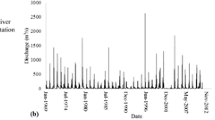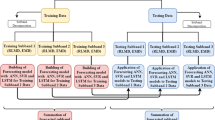Abstract
A nonlinear stochastic self-exciting threshold autoregressive (SETAR) model and a chaotic k-nearest neighbour (k-nn) model, for the first time, were compared in one and multi-step ahead daily flow forecasting for nine rivers with low, medium, and high flows in the western United States. The embedding dimension and the number of nearest neighbours of the k-nn model and the parameters of the SETAR model were identified by a trial-and-error process and a least mean square error estimation method, respectively. Employing the recursive forecasting strategy for the first time in multi-step forecasting of SETAR and k-nn, the results indicated that SETAR is superior to k-nn by means of performance indices. SETAR models were found to be more efficient in forecasting flows in one and multi-step forecasting. SETAR is less sensitive to the propagated error variances than the k-nn model, particularly for larger lead times (i.e., 5 days). The k-nn model should carefully be used in multi-step ahead forecasting where peak flow forecasting is important by considering the risk of error propagation.




Similar content being viewed by others
References
Amendola A, Niglio M, Vitale C (2006) Multi-step SETARMA predictors in the analysis of hydrological time series. Phys Chem Earth A/B/C 31:1118–1126
Ajmal M, Waseem M, Ahn J-H, Kim T-W (2015) Improved runoff estimation using event-based rainfall-runoff models. Water Resour Manag 29:1995–2010. doi:10.1007/s11269-015-0924-z
Aqil M, Kita I, Yano A, Nishiyama S (2007) Neural networks for real time catchment flow modeling and prediction. Water Resour Manag 21:1781–1796. doi:10.1007/s11269-006-9127-y
Brock W, Dechert WD, Scheinkman J (1987) A test for independence based on the correlation dimension. Working paper, University of Wisconsin
Chan KS (1991) Percentage points of likelihood ratio tests for threshold autoregression. J R Stat Soc Ser B Methodol 53:691–696. doi:10.2307/2345598
Chan KS, Tong H (1986) On estimating thresholds in autoregressive models. J Time Ser Anal 7:179–190
Chen Y, Chang L, Huang C, Chu H (2013) Applying genetic algorithm and neural network to the conjunctive use of surface and subsurface. Water Res Manag 27:4731–4757. doi:10.1007/s11269-013-0418-9
Chen C-S, Liu C-H, Su H-C (2008) A nonlinear time series analysis using two-stage genetic algorithms for streamflow forecasting. Hydrol Process 22:3697–3711. doi:10.1002/hyp.6973
Clements MP, Krolzig H-M (1998) A comparison of the forecast performance of markov-switching and threshold autoregressive models of US GNP. Econ J 1:47–75. doi:10.1111/1368-423X.11004
Cromwell JB, Labys WC, Terraza M (1994) Univariate tests for time series models. Sage Publications, Thousand Oaks
Dutta D, Welsh W, Vaze J, Kim SH, Nicholls D (2012) A comparative evaluation of short-term streamflow forecasting using time series analysis and rainfall-runoff models in ewater source. Water Resour Manag 26:4397–4415. doi:10.1007/s11269-012-0151-9
Grassberger P, Procaccia I (1983) Measuring the strangeness of strange attractors. Physica D 9:189–208
Hawley RJ, Bledsoe BP (2011) How do flow peaks and durations change in suburbanizing semi-arid watersheds? a southern California case study. J Hydrol 405:69–82
Jayawardena AW, Gurung AB (2000) Noise reduction and prediction of hydrometeorological time series: dynamical systems approach vs. stochastic approach. J Hydrol 228:242–264. doi:10.1016/S0022-1694(00)00142-6
Karlsson M, Yakowitz S (1987) Rainfall-runoff forecasting of methods, old and new. Stoch Hydrol Hydraul 1:303–318
Khatibi R, Ghorbani MA, Naghipour L, Jothiprakash V, Fathima TA, Fazelifard MH (2014) Inter-comparison of time series models of lake levels predicted by several modeling strategies. J Hydrol 511:530–545. doi:10.1016/j.jhydrol.2014.01.009
Komorník J, Komornikova M, Mesiar R, Szökeova D, Szolgay J (2006) Comparison of forecasting performance of nonlinear models of hydrological time series. Phys Chem Earth 31:1127–1145
Krause P, Boyle DP, Bäse F (2005) Comparison of different efficiency criteria for hydrological model assessment. Adv Geosci 5:89–97
Kunkel ML, Pierce JL (2010) Reconstructing snowmelt in Idaho’s watershed using historic streamflow records. Clim Chang 98:155–176
Latt Z, Wittenberg H (2014) Improving flood forecasting in a developing country: a comparative study of stepwise multiple linear regression and artificial neural network. Water Resour Manag 28:2109–2128. doi:10.1007/s11269-014-0600-8
Legates DR, McCabe GJ (1999) Evaluating the use of “goodness-of-fit” measures in hydrologic and hydroclimatic model validation. Water Resour Res 35:233–241. doi:10.1029/1998wr900018
Lisi F, Villi V (2001) Chaotic forecasting of discharge time series: a case study. J Am Water Resour Assoc 37:271–279
Liu Q, Islam S, Rodriguez-Iturbe I, Le Y (1998) Phase-space analysis of daily streamflow: characterization and prediction. Adv Water Resour 21:463–475
Makungo R, Odiyo JO, Ndiritu JG, Mwaka B (2010) Rainfall–runoff modelling approach for ungauged catchments: a case study of nzhelele river sub-quaternary catchment. Phys Chem Earth A/B/C 35:596–607. doi:10.1016/j.pce.2010.08.001
Modrick TM, Georgakakos KP (2014) Regional bankfull geometry relationships for southern California mountain streams and hydrologic applications. Geomorphology 221:242–260
Moeanaddin R, Tong H (1988) A comparison of likelihood ratio test and cusum test for threshold autoregression. J R Stat Soc Ser D 37:213–225
Ng WW, Panu US, Lennox WC (2007) Chaos based analytical techniques for daily extreme hydrological observations. J Hydrol 342:17–41
Patel S, Ramachandran P (2015) A comparison of machine learning techniques for modeling river flow time series: the case of upper Cauvery river basin. Water Resour Manag 29:589–602. doi:10.1007/s11269-014-0705-0
Phoon K, Islam M, Liaw C, Liong S (2002) Practical inverse approach for forecasting nonlinear hydrological time series. J Hydrol Eng 7:116–128
Pinson P, Christensen LEA, Madsen H, Sorensen PE, Donovan MH, Jensen LE (2008) Regime-switching modelling of the fluctuations of offshore wind generation. J Wind Eng Ind Aerodyn 96:2327–2347
Porporato A, Ridolfi L (1997) Nonlinear analysis of river flow time sequences. Water Resour Res 33:1353–1367
Safeeq M, Grant GE, Lewis SL, Tague C (2013) Coupling snowpack and groundwater dynamics to interpret historical streamflow trends in the western United States. Hydrol Process 27:655–668
Sharifazari S, Araghinejad S (2015) Development of a nonparametric model for multivariate hydrological monthly series simulation considering climate change impacts. Water Resour Manag 29:5309–5322. doi:10.1007/s11269-015-1119-3
Sivakumar B (2003) Forecasting monthly streamflow dynamics in the western United States: a nonlinear dynamical approach. Environ Model Softw 18:721–728
Tong H (1978) On a threshold model. In: Chen CH (ed) Pattern recognition and signal processing. Sijhoff and Noordoff, Amsterdam, pp 101–141
Tong H (1983) Threshold models in non-linear time series analysis. Springer, New York
Tongal H, Demirel MC, Booij MJ (2013) Seasonality of low flows and dominant processes in the Rhine river. Stoch Env Res Risk A 27:489–503. doi:10.1007/s00477-012-0594-9
Toth E, Brath A, Montanari A (2000) Comparison of short-term rainfall prediction models for real-time flood forecasting. J Hydrol 239:132–147. doi:10.1016/S0022-1694(00)00344-9
Wang W, Vrijling JK, Van Gelder PHAJM, Ma J (2006) Testing for nonlinearity of streamflow processes at different timescales. J Hydrol 322:247–268
Yu XY, Liong SY, Babovic V (2004) EC-SVM approach for real-time hydrologic forecasting. J Hydroinf 6:209–233
Acknowledgments
The authors would like to thank the U.S. Geological Survey for providing data used in this study.
Author information
Authors and Affiliations
Corresponding author
Rights and permissions
About this article
Cite this article
Tongal, H., Booij, M.J. A Comparison of Nonlinear Stochastic Self-Exciting Threshold Autoregressive and Chaotic k-Nearest Neighbour Models in Daily Streamflow Forecasting. Water Resour Manage 30, 1515–1531 (2016). https://doi.org/10.1007/s11269-016-1237-6
Received:
Accepted:
Published:
Issue Date:
DOI: https://doi.org/10.1007/s11269-016-1237-6




